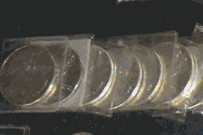

 |
|---|
 |
 |
 |
 |
 |
 |
 |
Best prices and service around.
–Tom, Placerville
 |
|
|---|---|
 |
 |
 |
|
 |
|
 |
|
Currency
Types | GRADING | Terms | CLEANING | DeFECTS| Grades
Physical Objects That Are Accepted as a Medium of Exchange.
Types: The physical objects that are usually accepted as exchange medium are coins and currency. For our explanation, currency will be Paper Money. Below are the types of currency that have been or are still being used in the U.S.
- 1690-1798 Colonial Currency issued by the States
- 1775-1779 Continental Currency issued by United Colonies
- 1791-1863 State chartered bank notes
- 1861 Demand notes issued by US Government ($5, $10, $20)
- 1862-1876 Postage & Fractional Currency (Cents: 3, 5, 10, 15, 25 ,50)
- 1862-1966 Legal Tender Issues ($1, $2, $5, $10, $20, $50, $100, $1,000, $5,000, $10,000)
- 1863-1864 Compound Interest Treasury Notes ($10, $20, $50, $100, $1,000)
- 1863-1929 National Bank Notes ($1, $2, $5, $10, $20, $50, $100, $500, $1,000)
- 1865-1934 Gold Certificates ($1, $2, $5, $10, $20, $50, $100, $500, $1,000, $5,000, $10,000, $100,000)
- 1857-1957 Silver Certificates ($1, $2, $5, $10, $20, $50, $100, $500, $1,000, $5,000, $10,000)
- 1914-Present Federal Reserve Notes ($1, $2, $5, $10, $20, $50, $100, $500, $1,000, $5,000, $10,000
Currency Grading: It is important that buyers and sellers alike be aware of all the grading terms. Grading is very important in this area. These are standard grading terms and values that are not written in stone but used by many dealers and collectors. Please understand that these are expected to be understood by the novice as well as expert dealer/collector.
To ensure a proper grade, always remove a note from a holder and view under good lighting. Take the note in hand, wearing cotton gloves, and move it around in the light side to side so you can see folds and creases.
Terms:
Handling: counting marks, pinces, and smudges.
Counting Marks: very light bends in the note which are not folds.
Pinches: similar to Counting Marks but inside the field of the note.
Smudges: results of skin contact to the inked surface.
Originality: notes/paper that have not been pressed or washed where embossing and paper wave should be present.
Embossing: note print can be felt on the face of the note espcially around the serial number and seal.
Paper Wave: light ripples that go across the top/bottom of the note and happens due to wet paper drying after printing.
Pinholes: early notes may have needle marks called pinholes that were made by sewing a stack of notes together to prevent theft. These notes are still considered by collectors. Newer notes that have similar holes will have a lower value as they are not the same.
Cleaning a Note: Never Clean a Note! Washing, pressing or cleaning a note will reduce its value. It will lose its original sheen and appearance and make it dull looking. There will always be signs of folds and creases even after attemting to do this cleaing.
Defects: Pencil or pen marks, glue, and tape may be removed if not too deep. These should be done professionally especially with a high end note.
Grades:
| GemCU/65-70 | Gem Crisp Uncirculated | |
|---|---|---|
| • Perfect margins front and back • Full embossing • No fading/aging |
• Bold/bright colors • Looks perfect/brand new |
|
| ChCU/64-65 | Choice Crisp Uncirculated | |
| • Nice note, but not Gem/CU • Most embossing present • Slight aging possible |
• Square corners • No folds/bends |
|
| CU/60-63 | Crisp Uncirculated | |
| • No trace circulation • May have centering problems |
• May have close margins, smudges, wrinkles • May have corner bend |
|
| AU/50-58 | Almost Circulated | |
| • May have single folds or bends • May have corner folds |
• Corners may be rounded | |
| XF/40-45 | Extra Fine | |
| • Circulated but retains some crisp features • Possibly 3-4 folds |
• Little fading • No stains |
|
| VF/20-35 | Very Fine | |
| • Moderate circulation • Possible loss of crispness and color |
• Possible multiple folds • Possible slight soiling |
|
| F/12-15 | Fine | |
| • Well circulated/little crispness left • Rough edges |
• Soiled or faded • Numerous folds |
|
| VG/8-10 | Very Good | |
| • Well soiled • Well worn |
• Rough edges • Some problems |
|
| G/4-6 | Good | |
| • Soiled and dark in appearance • Extremely worn • Extreme rough edges |
• Tears, splits, holes • Pieces missing |
|
| P/1-3 | Poor | |
| • Many thin spots • Major tears, holes, splits • Bigger pieces missing |
• Taped • Severe wear |
|
![[Most Recent Quotes from www.kitco.com]](http://www.kitconet.com/charts/metals/gold/t24_au_en_usoz_2.gif)
![[Most Recent Quotes from www.kitco.com]](http://www.kitconet.com/charts/metals/silver/t24_ag_en_usoz_2.gif)
![[Most Recent Quotes from www.kitco.com]](http://www.kitconet.com/charts/metals/platinum/t24_pt_en_usoz_2.gif)
![[Most Recent Quotes from www.kitco.com]](http://www.kitconet.com/charts/metals/palladium/t24_pd_en_usoz_2.gif)
![]()